air solution
we have made the air so bad that it stinks and traps heat in the atmosphere causing global warming and climate crisis.
When was the last time you had a breath of fresh air?
_ we ruined the sky so stop burning $#i+ and help nature

PM2.5 are at unhealthy levels
fine particles in the air are measured as PM2.5 and the fine particulate matter is at unhealthy levels.
why are you burning wood like a caveman?
"If we can't breathe the air then we die, if we can't grow food on it then we die, if we can't drink the water then we die."
How bad is your air?
Enter your ZIP Code to get local air quality index:
| levels of air pollution | |
|---|---|
| good | 0-50 |
| moderate | 51-100 |
| unhealthy | 101-300 |
| hazardous | 301 |
| AQI | |
air quality index AQI is the EPA's index for reporting air quality.
levels of air pollution. the indices used to measure air quality are: ground level ozone, particulate matter (pm2.5 and pm10), carbon monoxide, sulphur dioxide and nitrogen dioxide.
ArcGIS interactive map
data, GIS, mapping and spatial analytics: ArcGIS Living Atlas esri
air
end the fireplace
isn't it time to end the fireplace and do what we can to reduce smoke? Smoke is toxic air filled with particulates; particulate matter PM2.5 and breathing this can kill people.
what is the danger of smoke? Besides irritating the respiratory tract and the eyes, pollutants in the haze can cause serious long-term health damage.
sources of particulates are any type of common combustion including power plants, car and truck exhaust, restaurant grilling and wood burning, BBQ open-air wood burning and fast food charbroiling, grocery store food production, grilling, wood burning, and of course residential wood burning. End the fireplace.
can we end the fireplace along with all residential wood burning? Using a fireplace for heating is ridiculous since we have central heating. One wildfire can impact the climate. Millions of fireplaces can impact the climate. There are 140 million houses for 329 million people in the U.S. as of 2020.
fireplaces are wildfires
a residential wood-burning fireplace is like a small wildfire.
exposure to smoke poses immediate and long-term health risks. Immediate effects of inhaling smoke include shortness of breath, an elevated pulse, chest pain, or inflammation in the eyes, nose and throat. This is caused by small particles in the smoke haze which can enter the bloodstream and other parts of the human body, causing possible DNA mutations and other health issues.
smoke gets in your eyes.
PM2.5
fine particles in the air are measured as PM2.5 and the fine particulate matter is at unhealthy levels.
fine particulate matter are so small that they can travel deeply into the respiratory tract, reaching the lungs, causing short-term health effects such as eye, nose, throat, and lung irritation, coughing, sneezing, runny nose, and shortness of breath.
fine particulate matter is less than 2.5 microns in diameter, 1/30th the width of a human hair. It can lodge deeply into the lungs and pass through to the bloodstream, causing serious health affects such as respiratory illness, asthma, lung disease and heart disease.
long-term exposure to polluted air has increased the risks of heart and respiratory illness, including covid-19.
the current national standards limit annual concentrations of soot and other chemicals to 12 micrograms per cubic meter of air. Emissions on specific days are allowed to be as high as 35 per cubic meter, a standard set 14 years ago. These fine particles, which measure less than 2.5 micrometers in diameter, or one-thirtieth the width of a human hair, can enter the lungs and bloodstream, causing inflammation that can lead to asthma, heart attacks and other illnesses. Soot comes from a variety of sources such as industrial operations, incinerators, car and truck exhaust, power plants, smokestacks and burning wood.
long-term exposure to polluted air has increased the risk to heart and respiratory illness, including covid-19.
PM2.5 illustration: ArcGIS Living Atlas esri
it's us, it's bad, and we can fix it
the relationship of long-term air pollution and COVID-19 indicate adverse health impacts that make people prone to the infection. Extended exposure to severely polluted air can cause chronic lung inflammation which could leave people more vulnerable to the coronavirus.
transportation and power
ghg comes primarily from burning fossil fuels for energy use and transportation. Exhaust emissions from transportation is leading cause of smog.
New data released by the EPA on Friday, Feb12 2021, show that while emissions from the power sector continue to fall it remains the nation's 2nd largest source of greenhouse gas pollution. The biggest source, transportation, has continued to climb.
combustion
sources of fine particulates are any type of common combustion including power plants, car and truck exhaust, restaurant grilling and wood burning, grocery store food production, grilling, wood burning, residential wood burning, BBQ open-air wood burning, and fast food charbroiling.
why are you burning wood like a caveman?
danger of smoke. besides irritating the respiratory tract and the eyes, pollutants in the haze can cause serious long-term damage to health.
humans need oxygen O2 at nose level to live
humans need oxygen O2 at nose level to live. Trees clean our air and trees capture carbon dioxide in the atmosphere and produce oxygen. We need to protect trees from deforestation and plant more trees.
in Malaysia, because of the farming technique of clear-cutting the haze reached 208 on the Air Pollutants Index (API) in several districts. The clear-cutting causes wildfires which causes more and more smoke, which poisons more and more air.
ghg
CO2 levels at 400ppm
global levels of carbon dioxide CO2 passed 400ppm, while 100ppm is considered an unhealthy amount of greenhouse gas (ghg).
air pollution can cause hypertension, diabetes and respiratory diseases, conditions that doctors are starting to link to higher mortality rates for covid-19.
deaths every year from outdoor air pollution: 4.2 million people worldwide. Air pollution WHO
the immune system. Air pollution and damages to immunity EPHA
air pollution can cause hypertension, diabetes and respiratory diseases, conditions that doctors are starting to link to higher mortality rates for covid-19. Air pollution exacerbates chronic lung and heart conditions. Air pollution caused conditions: the risk of co-morbidities EPHA

we must ensure that air pollution standards protect the public's health. air pollution kills sciencemag.org
we can reduce air pollution by setting air quality standards, monitoring levels of air pollutants, and enforcing regulations. The goal is to reduce air pollution of fine particulates and noxious gases. The only way to get there is to immediately transition the global economy away from fossil fuels and into renewable energy, energy efficiency, and sustainable farming practices.
burning coal, oil, ngas is damaging the atmosphere
yes, the world needs energy, and we can use clean energy like solar and wind energy, instead of coal, oil, and methane-producing natural gas (ngas). Pollution from burning coal to make electricity is damaging the atmosphere. Leaks from oil production and transportation are damaging the oceans and rivers which is destroying our drinking water. Combusting fuel in cars and trucks is producing tailpipe emissions that react with sunlight to form smog which is causing the atmosphere to warm.
global CO2 >400ppm
global levels of carbon dioxide CO2 passed 400ppm. Climate change is intensifying and the stability of the planet is at stake. Greenhouse gas emissions must be reduced by 80% by 2050.
parts per million by volume are the units of measure for the air quality standards for pollutants. 100ppm is considered an unhealthy amount of greenhouse gas (ghg). 350ppm is the safe upper limit. The earth's atmosphere hit 400ppm in March 2015, and 403ppm in 2017.
trees
trees help to clean the air we breathe. Trees eat carbon dioxide CO2 and give oxygen O2 We have to breathe or else we die, immediately.
charting CO2 noaa.gov National Oceanic and Atmospheric Administration
Global Climate Change climate.nasa.gov NASA - Vital Signs of the Planet
ghg CO2 and CH4
greenhouse gases ghg are noxious gases like carbon dioxide CO2 and methane CH4 that trap heat in the atmosphere. Heat in the atmosphere negatively affects the climate for human life. A 1°C rise in the temperature of the Earth is already causing storm surges, floods and wildfires.
carbon dioxide CO2 and methane CH4 are potent greenhouse gases that absorb the sun's heat, thus adversely warming the atmosphere.
methane is 30 times more potent than CO2 and is a major contributor to climate change. Methane is the main component of natural gas ngas.
methane is the primary component of natural gas, a common fuel source. The oil and gas industry produce industrial emissions of methane pollution. Methane is currently allowed to leak into the air in the fracking process, and 25% gets leaked into the atmosphere during distribution.
WHO (World Health Organization) has been campaigning to decrease toxic pollution around the globe, educating the public on the dangers to health. Its guidelines for PM2.5 is no more than 10 micrograms per cubic meter. ug/m3 is a measurement of density.
gas stove
the burners on gas stoves release pollutants including nitrogen dioxide, a key element in smog that can irritate airways and may contribute to the development of asthma, according to the U.S. Environmental Protection Agency. Researchers at Stanford University recently found that cooking with gas and propane stoves may be contributing to the deaths of approximately 19,000 adults in the United States annually, as well as around 200,000 current cases of childhood asthma. Stanford University researchers have also found that gas stoves can emit benzene, which is linked to cancer.